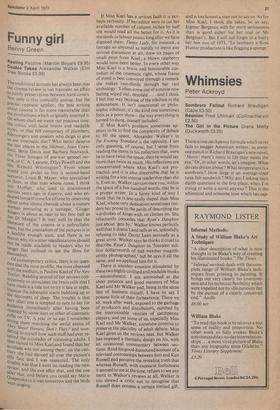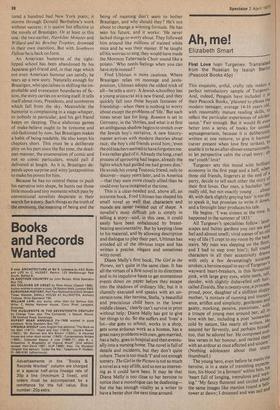Whimsies
Peter Ackroyd
Sombrero Fallout Richard Brautigan (Cape £3.50) Reunion Fred Uhlman (Collins/Harvill £2.50) The Girl in the Picture Diana Melly (Duckworth £3.25)
There is one catchpenny formula which never fails to stagger American writers: as someone puts it in Richard Brautigan's new novel, 'Motto: there's more in life than meets the eye.' Or, in other words, let's imagine. What do cats dream about? What temperature is a sombrero? How large is an average-sized tuna fish sandwich ? Why am I asking such dumb questions in the first place, when I'm trying to write a novel anyway? This is the whimsical and winsome tone which has cap tured a hundred bad New York poets; it storms through Donald Barthelme's work without success; it is quaint but effective in the novels of Brautigan. Or at least in this one : the two earlier, Hawkline Monster and Willard and his Bowling Trophies, drowned in their own inanition. But with Sombrero Fallout he is back on form.
An American humorist of the tightlipped school has been abandoned by his Japanese girl-friend and, in that rage which not even American humour can Satisfy, he tears up a new story. Naturally enough for Brautigan, who specialises in shifting the improbable and evanescent boundaries of fiction, the story carries on writing itself. It tells itself about riots, Presidents, and sombreros which fall from the sky. Meanwhile the humorist is complaining in a stage-whisper, to nobody in particular, and his girl friend keeps on sleeping. Thee elaborate games of make-believe ought to be tiresome and old-fashioned by now, but Brautigan makes a habit of being readable. He also keeps his chapters short. This must be a deliberate ploy on his part since the flat tone, the deadpan manner, the enumeration of comic and not so comic particulars, would pall if delivered at length. As it is, Brautigan depends upon surprise and wittyjuxtaposition to make his points for him.
Because he has no central theme to push his narrative into shape, he hunts out those little moods and tiny moments which pass by conventional novelists desperate in their search for a story. Such things as the truth of the emotions, the meaning of being and the
being of meaning don't seem to bother Brautigan, and why should they? He's not about to change a winning formula. He has seen his future, and it works: 'He never lacked things to worry about. They followed him around like millions of trained white mice and he was their master. If he taught all his worries to sing, they would have made the Mormon Tabernacle Choir sound like a potato.' Who needs feelings when you can have style instead ?
Fred Uhlman is more cautious. Where Brautigan relies on montage and juxtaposition, Uhlman adopts the oldest trick of all—he tells a story. A Jewish schoolboy has a young aristocrat as a new friend, and they quickly fall into those boyish fantasies of friendship—when there is nothing to worry about except the problems of 'life.' But such times never last for long. Reunion is set in Germany, in the 'thirties, and what is at first an ambiguous shadow begins to stretch over the Jewish boy's narrative. A new historymaster arrives with modern theories about race; the boy's old friends avoid him;,`even the old teachers seemed to have forgotten me. I was rather glad of it. Already the long, cruel process of uprooting had begun, already the lights which had guided me had grown dim.' He avoids his young Teutonic friend, only to discover—many years later, and in America —that they were more closely allied than he could ever have imagined at the time.
This is a clear-headed and, above all, an accurate book. Fred Uhlman has shaped his small novel so well that characters and moods are never twisted out of shape. A novelist's most difficult job is simply in telling a story—and, in this case, it could easily have been unbalanced by breastbeating sentimentality. But by keeping close to his material, and by allowing description and dialogue to play their part, Uhlman has avoided all of the obvious traps and has written a precise, elegant and sometimes witty novel.
Diana Melly's first book, The Girl in the Picture, isn't quite in the same class. It has all the virtues of a first novel in its directness and in its impulsive haste to get momentous events down on paper before they escape into the shadows of ordinary life; but it is clumsily executed and speaks with an uncertain tone. Her heroine, Stella, 'a beautiful and precocious child born in the lower middle classes,' clearly can't survive in print without help: Diana Melly has got to give her things to do. So she suffers and 'lives' a lot—she goes to school, works in a shop, gets some arduous work as a hostess, has a great many problems with men, gets married, has a baby, goes to hospital and then eventually into a nursing home. The novel is full of details and incidents, but they don't quite cohere. There is too much and not enough scenery. The Girl in the Picture is not so much a novel as a way of life, and so not as interesting as it could have been. It may be that Diana Melly' is too close to her heroine to notice that a monologue can be deafening— but she has enough vitality as a writer to have a better shot the next time around.







































 Previous page
Previous page